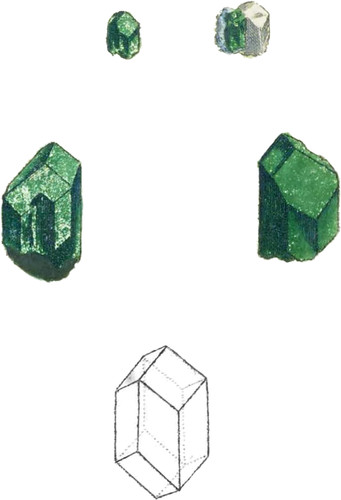 Enlarge
Enlarge
Exotic Mineralogy
Dioptase
- Syn.
- Cuivre dioptase. Haüy, Tabl. 91.
- Dioptase. Haüy, Traité, 3. 136.
- Kupfer schmaragd. Werner.
This substance, precious from its rarity, has been confounded with the Emerald from its colour. It is from the north of Asia; the specimens were more costly than real Emeralds of the same dimensions; it is, however, very well for the merchant that the Emerald, most useful as a gem, for ornament, &c, is sufficiently hard, while the Dioptase would soon wear out of shape, as it is not much harder than Carbonate of Lime. I should rather think it belongs to the. Lime than the Copper genus. Its crystal is an hexaëdral prism, terminated by an acute three-sided pyramid, which is composed of the primitive planes. The beauty of colour is very conspicuous, and is highly increased by the lustre, which is superior to that of Carbonate of Lime. The fracture is vitreous. Before the blow-pipe it becomes of a chesnut brown colour, giving a greenish colour to the flame. Melted with Borax, it gives a globule of Copper, but is infusible without addition. The matrix is Carbonate of Lime, Spec. Grav. 2.850 to 3.300.
| Carbonate of lime | 42.85 |
| Silica | 28.57 |
| Oxide of copper | 28.57 |
| 99.99 |
Said also, to be found in the land of the Kerguise, some distance from the Russian frontier. Pallas says it is found in the mountain called Altin de Karassu; the matrix is white Carbonate of Lime and Copper ore.

